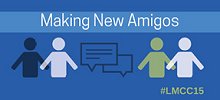 |
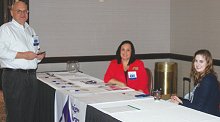 |
| Amigos Library Services’ Keith Gaertner, Pam Carter, and Megan Bryant handled everything at the registration table. (photo by Kathy Dempsey) |
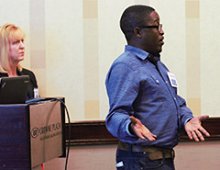 |
| Tommy Hardin with Mary Altman from the Mid-Continent Public Library. (photo by Jennifer Burke) |
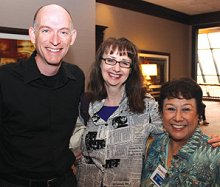
|
| Chair Kathy Dempsey (middle) with keynote
speakers David Lee King and Yolanda Cuesta. (photo by Curtis Rogers) |
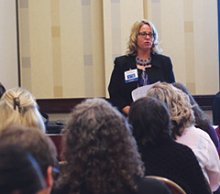 |
| Heidi Nagel discussed a ballot issue. (photo by Jennifer Burke) |
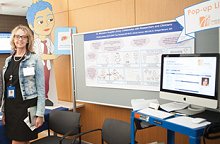 |
| One of the St. Michael’s slides showed Sandy Iverson with the pop-up library and a promotional avatar. |
A new conference for library marketing workers took place Nov. 3–4, 2015. The event attracted more than 200 people from all over the U.S. and Canada, and even one from South Africa! We gathered in the town of Addison, Texas, a suburb of Dallas, to share our knowledge and experiences. By all counts, this Library Marketing and Communications Conference (LMCC; www.amigos.org/lmcc) was a great success, and it promises to be the first of many. I, your trusty MLS editor, also happened to be the event’s chair, so I’ve got the inside scoop.
One of the most unusual things about the LMCC was the way it came together. A group of 16 people (many of whom had never even met) created the conference with the help of a small vendor (that most of us had never worked with)—and we did it in just 6 months.
Starting the Show
Our Planning Committee of 16 people from across the U.S. and Canada formed in February 2015. It quickly became evident that we couldn’t run a conference by ourselves, since we were not a legal entity with bank accounts. We became aware of Amigos Library Services (www.amigos.org) in March, but various challenges kept us from ascertaining the company’s involvement until early May. Amigos had everything we lacked—financial expertise, a full-time staff, an online registration system, and a history of conference planning. We’d found the perfect partner. By early June, our main Amigos contact, chief internal audit and IT officer Keith Gaertner, had reserved meeting space and sleeping rooms for the 50 to 75 people we expected in an Addison hotel that the company regularly used for other meetings. The Planning Committee had shrunk to 14 people, and work began in earnest for a new November conference.
To say that June, July, August, and September were incredibly busy for us would be an understatement, but everything came together. I led the team of planners as we put out a call for papers, combed through 101 proposals, and signed up more than 40 speakers plus two keynoters. Later, we devised a session schedule and designed a conference program. Gaertner led the Amigos staffers who had the massive job of handling all registration and payment duties. They also negotiated with the hotel managers on all of the arrangements for spaces, tech, and food service. Gaertner and I spoke often to keep plans on track.
I proposed the conference theme of Making New Amigos for three reasons. First, we knew that attendees would be pretty “cozy” because we sold out our space—twice. We surpassed our keynote room’s capacity of 150. Gaertner was able to finagle more conference space, getting us up to 200 seats, but they also sold out quickly. Second, I aimed to encourage lots of networking (via breaks between sessions, discussion topics at luncheon tables, and organized dine-arounds for dinner). Finally, I wanted to give a nod to our amazing vendor partner, since LMCC wouldn’t have been possible without its support. So Making New Amigos referred not only to my team and Gaertner’s but also, we hoped, to every attendee who would (inevitably) get to know some of the others in our close quarters.
Meeting at Last
On Monday, Nov. 2, Dallas’ two airports were full of librarians. Unfortunately, a few of the Planning Committee members couldn’t make it, but 11 of us did. After working together so intensely, we felt as if we were “meeting” old friends for the first time. We were happy, excited, and a little nervous to see how the show would go.
LMCC 2015 officially began on Tuesday morning, with people from both organizing partners still working together. Amigos’ staffers manned the registration table and provided AV support, and Planning Committee members acted as moderators for each session room. We kicked off at 9 a.m. with the popular David Lee King (www.davidleeking.com) as the opening keynote speaker. His talk was based on his book, Face2Face: Using Facebook, Twitter, and Other Social Media Tools to Create Great Customer Connections. He offered three pieces of advice for successful social media:
1. You need to listen and to respond appropriately. Have two-way conversations. They can’t go in just one direction—either librarians pushing their own info or fans making comments that go unanswered.
2. It’s vital to “be human” in your online interactions. Don’t sound like a stuffy business in your posts or responses. “Type like you talk,” he urged. “Sound friendly and professional at the same time.” Since that can be easier said than done, King clarified his advice: When you write posts or replies, be “business casual” but not “weekend casual.” Savvy!
3. You need to “do community.” It’s important to allow comments on your website and to enable replies on social media platforms. Even though you can’t control what people will write, let them voice their concerns so you can address them.
After King finished, we had a 30-minute beverage and networking break while hotel staff separated the large keynote room into three session rooms. We had one more room down the hall, so there were four concurrent tracks:
- Marketing Planning & Strategies
- Communications Campaigns
- Collaborations & Partnerships
- Design & Technology
Each track had one session before lunch, then three more after lunch. Since I wandered among many of them, I’ll share highlights on many topics.
Recommendations and Roadmaps
In Telling Your Library’s Stories With Articles and Videos, Jennifer Burke, president of IntelliCraft Research, LLC, told listeners, “Video’s hot and only getting hotter.” She went over various video-making hardware and software. Burke said one way to get guaranteed viewers is to “take your FAQs and your common reference questions and crank out a video or screencast.” She also suggested filming quick video tours of confusing buildings and reminded us to always include the benefits of using libraries.
In Developing Your Annual Marketing Roadmap, a big crowd listened to three speakers from the 31-library Mid-Continent Public Library system, near Kansas City, Kan. Marketing manager Mary Altman began by outlining how to create annual plans based on how her staff does it.
1. Review strategic plans and program/event calendars 14–15 months ahead of time.
2. Review your budget.
3. Commit to writing a marketing plan. To inform that, look back at the previous year to see which numbers (attendance, usage, etc.) are up or down. Look at previous campaigns. Make lots of sub-plans to cover everything.
Altman recommended writing a full year’s media plan. She likes to speak to editors and writers to help organize a calendar of coverage. During those meetings, she advised, “put it on the table” that you’d like donations of advertising space or dollars. She tells media managers, “Investing in you [the library] invests in their community.”
Mid-Continent’s online marketing coordinator Tommy Hardin said that, for web content, he plots which programs to highlight a few months out and has blog posts written ahead of time too. And he follows the “80/20 rule” that says make 80% of your posts about the readers and only 20% of them about the library.
From Opposition to Costumes
In When You Can’t Call to Action: Marketing Library Millage Campaigns, Heidi Nagel had a frank discussion about a 2014 effort at Kent District Library (KDL) in Michigan. She worked with a citizens group and with EveryLibrary (www.everylibrary.org), a nonprofit that helps with ballot initiatives. She discussed going door-to-door to talk with residents: “Definitely do it,” she said, because it can have a “huge impact.”
What I found most interesting was Nagel’s story about “opposition engagement.” Her team set up a meeting with an anti-tax Tea Party group that it anticipated trouble from. The library team shared financial information and showed off its ROI data. The anti-tax people were so thankful to have been respected and invited to the table, Nagel said, that they ended up saying, “We won’t fight you.” In fact, they started telling “anyone who would listen” how great the library was. So KDL won over its opponents, and its millage passed with 57% of the vote.
The final session I attended on Tuesday was Using Humor and Creativity to Increase Engagement and Library Value. I was intrigued that this session was coming from medical librarians at the large, inner-city St. Michael’s Hospital in Toronto. This place concentrates on trauma and critical care, yet, “Being strictly professional doesn’t help us connect with our audience,” admitted Sandy Iverson, manager of health information and knowledge mobilization. “Humor triggers memorability.”
Iverson explained that a library move opened up an opportunity “to tell a new story.” The staffers planned some fun, brief presentations, then did a “road show” in which they were given 5 minutes at meetings of various stakeholder groups. They built a pop-up library (display) that goes to nurses’ rounds monthly, to show off resources. And that’s not all. During a 2-hour open party, the library provided pieces of costumes to dress up in (hats, moustaches, etc.), and it
encouraged visitors to have fun hamming it up. The staffers took photos of each impromptu costume, then held a contest with the photos. “These are opportunities for us to present ourselves in a different way,” Iverson stressed. And it worked: They got feedback such as, “You guys are so much fun. You’re always doing something new.”
On Tuesday night, many LMCC attendees took advantage of dine-arounds that the Planning Committee had organized. Since most of the people were the lone attendees from their libraries, we wanted to help them find dinner companions.
Wednesday’s Eye-Opening Keynote
The second day of the LMCC began with an interesting keynote by Yolanda Cuesta, who runs Cuesta MultiCultural Consulting (www.yolandacuesta.com) and specializes in helping librarians serve diverse communities. She began her talk, called Reaching Multicultural Customers: The Personal Touch, with stories of her own youth. She grew up in Laredo, Texas, a town on the Mexican border, in a very “bilingual, bicultural world.” Back then, families regularly crossed back and forth between the U.S. and Mexico, to go shopping, to visit family and friends, and to do things as mundane as getting a haircut.
Cuesta pointed out that many world cultures have more in common with each other than they do with those of us from North America. When dealing with people in everyday life, it’s important to understand differences such as these:
- North Americans see direct eye contact as a sign of respect and readiness to engage. Other cultures lower their heads and eyes as a sign of respect. So librarians might think that people aren’t listening when in fact they are actually deferring to the librarian as an authority figure.
- North Americans are all about being punctual, but in other cultures, “time is elastic and infinite.” You get there whenever.
She then discussed these differences as they apply to libraries. Many immigrants see big buildings as intimidating. Libraries are government entities that ask for all of their personal information in order to get privileges, which is frightening to some who’ve been persecuted by their governments. To fight these misunderstandings, Cuesta recommended getting out of your buildings, befriending leaders of diverse communities, and concentrating on the aspirations and goals of people from other places. Don’t assume they even know what public libraries are for. One insight I gleaned is, when targeting Latinos, realize that they don’t really notice white or buff papers. They’re used to lots of color, so put promotional materials on brightly colored backgrounds.
Segmenting Data; Understanding Admins
Our second day also featured four tracks:
- Marketing Planning & Strategies
- Communication Campaigns
- Events & Outreach
- Social Media
After the morning’s break, I attended Segmented Messaging: Data-Driven Customer Engagement. Lisa Wells, assistant director of library services at the Pioneer Library System (PLS) in Norman, Okla., spoke alongside Clark Swanson, CEO of OrangeBoy, Inc., a vendor that helps collect and interpret information. PLS had been collecting data and “wanted to track customer behavior and tie it into services,” Wells told us. Together with OrangeBoy, PLS used data to identify various user groups, such as “Digitarians” (people who often use mobile devices). They especially sought to bring back “Occasionals” who had library cards but rarely used them. Wells wanted to “message with intent” so they worked to attract this segment back to the library and were measuring their success via card activity. (This project began in June 2015 and is ongoing.)
The Future Looks Bright
We ended the event with an All-Conference Wrap-Up Session, where we got some great feedback. At www.amigos.org/lmcc, you can see the full conference program and sign up for our email list.
Overall, the atmosphere of LMCC 2015 was incredibly positive. I lost track of how many people approached me during the 2-day event to thank us for running a conference on these specific topics, and my teammates and the Amigos staffers had the same experience. We seem to have filled a real need. We’re already starting to plan a 2016 conference, so stay tuned; I’d love to see you at LMCC 2016.
|